
Over the Christmas holidays, I decided it was time to watch Monty Python’s Life of Brian with my teenagers. This was not just because I found it in a charity shop on DVD for a pound, although that may have had something to do with it. And so, what if I did wrap it up and put it under the Christmas tree along with Monty Python and the Holy Grail?
Let’s focus on the real question here: what was it like watching this much-loved but controversial movie from 1979 in early 2025? And what would my church-going, Bible reading, Gen Z teenagers make of it?
This movie was not entirely new to them. I’d already shown them one of the finest sketches you will ever see, in which Brian has to learn to haggle for a beard whilst on the run. I’d also shown them ‘Romani Ire Domus’ sketch as I was teaching them Latin as part of their home education. I told them to expect more brilliant sketches like this, but that the movie is essentially “a bag of bits”. And that the ending is a disaster. More of that later.
Here are some of their reactions:
“Wow! This is soooooo Horrible Histories.”
It was. And it was even more resonant when we watched Monty Python and The Holy Grail. This is not a criticism. After all, who doesn’t love Horrible Histories? Especially the first cast who went off and made a truly brilliantly funny movie you probably haven’t seen about William Shakespeare called Bill. I think we’ve seen it as a family at least eight times. But they could see the legacy of Monty Python fifty years on.
“What’s with that bit with the space craft?”
I don’t know. Maybe they had to find something for Terry Gilliam to do.
“Why are you fast forwarding that bit?”
The movie contains unnecessary and tawdry nudity. As a parent, I reserve the right to censor the movies my children watch.
“Is that it?”
The movie is admirably brief at 93 minutes. My kids were just startled by the fact that the movie ended, without an ending. I’d prepared for them for this. After all, Bill has a proper beginning, middle and end. (Seriously. It’s great. Watch it) My kids have watched a lot of Pixar movies which are normally honed to plot perfection (with the exception of Soul which is a plot hot mess. And, as a jazz fan, I really wanted to love that movie.)
The ending of Life of Brian is poor, by any measure. It’s not just the fact that the crucifixion scene makes light of something savagely sad and sacred. It’s more that the movie ends with Brian abandoned to his fate on a cross while Eric Idle sings the cheerfully stoic Always Look on the Bright Side of Life while they all bake under the hot sun. And that’s it. The movie is over.
It’s slightly better than the non-ending of Monty Python and the Holy Grail, which comes clattering to a halt after the allotted time. I read somewhere that there simply wasn’t any money to do anything else. Clearly, Life of Brian, a few years later, had a bigger budget so there was at least an attempt at an ending. But a song, even a good song, doth not an ending make.
The song’s chirpiness belies the brilliance of it. With some neat rhymes and a simple, singable hook, the song achieves exactly what it sets out to achieve: stoic reassurance and an encouragement to put a brave face on things. It’s a funny contrast given they’re all being crucified, albeit in a comical pain-free way without nails and blood.
We shouldn’t be surprised that this is a message coming from relatively young men who’ve had a good education, been lauded as great comedians and made a lot of money. And still have their whole lives ahead of them in 1979 (although Graham Chapman died ten years later aged 49.) The fact the Pythons have nothing to say about life, death, suffering, pain, betrayal, the universe or anything isn’t their fault. Nor should we look to such sketch comedians for profound insights about the human condition.
How I felt
Here's how I felt as I watched Brian grasp the absurd injustice of his fate on a cross in the closing scene: I sensed the spirit of Douglas Adams, writer of Hitchhikers Guide to the Galaxy. The first series was broadcast on BBC Radio in 1978, the year that Life of Brian was being filmed in Tunisia. Adams writes about a universe that feels like it should make sense. But it doesn’t. It feels like there should be justice. But there isn’t. Which is funny. But also a bit sad.
The protagonist, Arthur Dent, is like Brian: a victim of circumstance, pushed from pillar to post by idiots and monsters. Ford Prefect constantly explaining the plot while Arthur Dent is dragged along, persisting with a middle-class simmering indignation that seems to last into eternity. But then, it’s a sitcom, so it’s not supposed to end.
A movie is a different proposition. We do not need to get bogged down with talk about the ‘hero’s journey’ for long but by the end of Life of Brian, our hero is only halfway through his quest. He has crossed the threshold by joining the People’s Front of Judea. But then what? He becomes disenchanted and realises he is going to have let go of something in order to grow and move on. But he doesn’t. He’s tied to a cross, abandoned and left for dead.
What other ending could there have been? I did have one idea. That Jesus, who is also in the movie, raises him from the dead. Brian says thank you, decides against becoming a disciple and makes a living as a cheesemaker. It’s a funny call-back, but still not satisfying, is it?
The problem is that Brian doesn’t have any true desires deep down. He doesn’t have a quest. That’s because this movie started life as a parody of Jesus, whose story its own natural beginning, middle and surprising but satisfying end. But the Pythons found that the life of Christ is rather compelling and challenging when you take the time to read what he actually said and did, so the focus shifted. What if Brian were mistaken for a messiah? The target became a mistaken identity comedy about organised religion.
Looking Back
46 years later, does Life of Brian still feel like searing satire on organised religion? Not really. Brian is not mistaken for the Messiah until almost 50 minutes in. The movie is more than half over. There are religious themes and sketches before that point, such as the scene in which the blasphemer is to be stoned (by women in beards), the ex-leper beggar healed by Jesus “without so much as a ‘by your leave’!”.
Brian only starts preaching to avoid being noticed by the soldiers. A crowd gathers and we’re into the ‘consider the lilies’ sketch, which I’ve always found funny. (And I never felt this was threatening or undermining the original version spoken by Christ himself, although I think of it every time it’s read aloud in church).
And then, the movie turns. Once the soldiers have gone, Brian stops talking. But this leaves the small crowd on a cliffhanger. They are now hanging on his every word. As he tries to get away, they turn his gourd and sandal into relics. He runs, but is found. We get the “very naughty boy” line, Brian addresses a crowd in the ‘you are all individuals’ sketch. Soon afterwards he’s arrested, and that’s the end of that. The religious themes fall away. It is hardly a coruscating broadside salvo on organised religion, although I understand why it might have felt like that at the time.
Watching it now when religion has declined for a further 45 years since 1979, the blows do not really land as they may have done at the time. This places further pressure on the ending which does not deliver as it was never intended to.
But seeing the chipper, upbeat stoicism at the end through the eyes of my kids was really interesting. They know that Disney and Pixar and now Disney Pixar have been trying to tell kids for decades that you should ‘believe in yourself’. They are rightly sceptical about messages of self-belief. So, it’s quite strange to see a movie with a religious theme end with song and a whistle and the idea that you don’t need to believe in anything at all. But that you should smile anyway.
What a curious conclusion. The fact that it felt so strange in 2025 might suggest that the British optimism in the face of death and injustice isn’t really good enough anymore. Maybe this will encourage us to go back to the original. After all ‘Blessed are the Cheesemakers’ is only funny if you know want what Jesus actually said at the Sermon on the Mount. Maybe a new generation will want to take the time to read what he actually said and did.
Join with us - Behind the Seen
Seen & Unseen is free for everyone and is made possible through the generosity of our amazing community of supporters.
If you’re enjoying Seen & Unseen, would you consider making a gift towards our work?
Alongside other benefits (book discounts etc.), you’ll receive an extra fortnightly email from me sharing what I’m reading and my reflections on the ideas that are shaping our times.
Graham Tomlin
Editor-in-Chief





